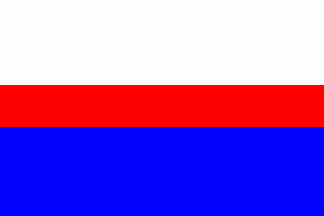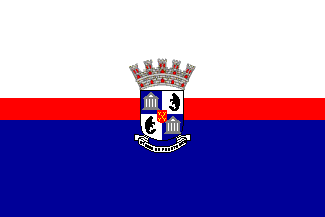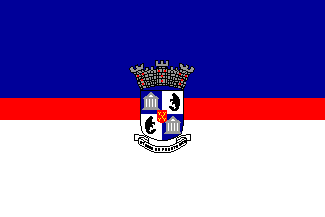
by Blas Delgado, 2 October 2002

Last modified: 2014-05-22 by zoltán horváth
Keywords: puerto rico | manati |
Links: FOTW homepage |
search |
disclaimer and copyright |
write us |
mirrors

by Blas Delgado, 2 October 2002
See also:
Two flags . A plain triband
is from pueblos-de-puertorico.com site (Not available at the
moment) .A flag with CoA is at lexjuris site
. The scroll reads 'Atenas de Puerto Rico', as indicated by two
temples on the CoA. Manati is on the central north coast of
Puerto Rico. It was founded in 1739 and there are 39,659 inh.
Jarig Bakker , 2 Febuary 2000
I found an error on the Manati flag that was correctly pointed
out by Mr. Juan Colo'n De Jesu's. My original
flag was based on the Lexjuris site (wrong). The triband
color order should be white-red-blue with the shield in the
center or without it.
Blas Delgado, 31 March 2001
The shield in the flag should have a five-turreted mural crown
instead of three.
Blas Delgado, 2 September 2001
My liaison at Arecibo got an official information from Manatí
City Hall who told him that the flag has never been flown and
never has existed with the City Shield in the middle. This
was an erroneous interpretation from the LexJuris and the defunct
pueblos-de-puerto-rico sites. Also, the official flag
description has the middle red band half the width of the other
twobands.
Blas Delgado, 2 October 2002

by Blas Delgado, 2 September 2001

by Blas Delgado
based on lexjuris
site
From <www.ngw.nl>:
"The first and second quarter show two Greek temple facades.
These refer to the 1900-1920s, when Manati was a major centre on
Puerto Rico for culture, literature and arts. The town was named
the 'Athens of Puerto Rico'. The second and third quarter show
two manatees (dolphin-like animals) and are used as a canting
element. Although (as in other coastal areas) there are
appearances of manatees in the area, the name really derives from
the name MANATUABON, given by the long-gone Taino natives to the
local river (meaning something like: "river of the high and
beautiful flower"). The escutcheon with the flames
symbolises the festivities in honor to the Virgin "de la
Candelaria", the patron of the city, whose festivities call
for the burning of bushes and tree branches."
Nelson Román, 8 July 2004